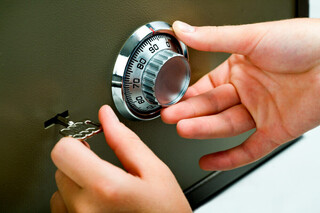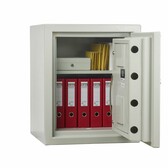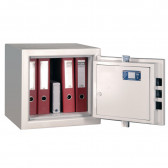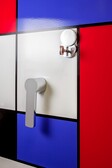While there is a huge and varied choice among safes in terms of class and size, there are literally four locking methods. The type of lock with which you secure your safe will not determine the level of security of the safe, however, the choice will affect how you use the safe. Let's take a brief look at the differences.
How do you use a key lock?
Key locks are standard equipment on most safes. Their use is intuitive for everyone, and the price of the lock itself is usually included in the price of the safe itself as an integral component. However, despite appearances, the advantages of this solution end at the price, such locks can cause more trouble than we think. The lock has a hole, which is its weak point.
Our service has been called on more than once to repair a lock where unruly toddlers have forced chewing gum into the hole. The key to a top-class safe is also a rather bulky object; at several centimetres long, it is closer to a bladed weapon than to the keys with which we lock our doors. And what if the key is lost or stolen? Two are supplied with each safe as standard. There are no digital key templates, so if one is lost, the other must be sent back for service. The process is costly and lengthy.
How does a mechanical combination lock work?
The principle of how a mechanical combination lock works is known to anyone who has at least once watched "Vabank" directed by Juliusz Machulski, whose main character is a cashier, representative of the noble though anachronistic profession of burglars specialising in opening safes. Not with a burner, but by ear, putting a stethoscope to the door, such a cashier was able to hear the sound of jumping dials and thus guess the cipher. Today's locks are resistant to this type of procedure, the moving parts being silenced.
Cipher locks have a number of features that make them popular, especially with customers who are averse to electronics. Opening is performed here by means of dials set in motion, so the lock needs neither power nor maintenance. In fact, the simple mechanism is difficult to fool, and it takes a lot of effort to break the lock. Opening a safe secured in this way has its own flavour, is rewarding, but requires patience and precision. The choice you make depends on how you want to use the safe. If the idea is to look into the safe quietly, unhurriedly and not too often, then this is the right lock for you. However, if the safe accompanies you at work and you open it several times a day in a hurry, then definitely choose an electronic lock.
Read also: Which combination lock safe to choose?
What are the advantages of an electronic lock?
The lock that the vast majority of customers choose, because of its speed and ease of use, is the electronic lock. There are many models of this type of lock provided by reputable suppliers. The most interesting features are the number of programmable users, the options for reading operations, the method of changing batteries or the four-eye mode, i.e. opening the lock with two separate codes. Some locks also have key revision, i.e. a physical key for emergency opening. This feature can be very helpful, but remember to keep the key away from the safe and, if possible, preferably at a different address.
Electronic locks are very easy to handle, both at the programming stage and in use. All you have to do is enter a pre-defined code and, when you hear the appropriate sound to signal the lock to release, pull the handle.
Each of the electronic locks we offer has a battery replacement option. Some models have the batteries hidden under the keypad, simply lever it up with your thumb to replace the battery with a new one in a matter of moments. Others have the battery slot hidden inside the door, in which case there are poles in a suitable place under the keypad to which a new battery must be applied. In this way, by powering up the lock in an emergency, we open the safe and replace the batteries.
Is it worth buying a biometric lock?
The most tempting for lovers of technological novelties is a biometric lock. The usability side of such a solution is probably familiar to every smartphone user. The lock, like a reader on a phone, collects information from the fingerprint and matches it to a pre-programmed pattern. As security is key, the reader differs from those available on smartphones, but is closer to the models present on laptops. The finger needs to be moved along the scanner.
As with electronic locks, there is also an emergency opening option with a physical key. In this way, the safe can be opened in the event of a power cut. This is because biometric locks require a permanent power supply.
A difficult choice?
Not necessarily, it depends on how you look at it. Statistics mercilessly show that electronic locks reign supreme among safes, and there are solid reasons for this. They offer the best ratio of ease of use, security and price, while the choice and multitude of functions within this group is the richest. However, as the bearded joke goes, when a man walks his dog statistically they both have three legs each. The choice of lock is an individual thing and it is entirely up to you which one guards your safe.
This may be interesting for you: Overview of popular locks in safes
Vandyke – the story of the most famous bank robber in Polish history





